Human Resource Management Report: Competitive Advantage Analysis
VerifiedAdded on 2021/06/17
|13
|3556
|24
Report
AI Summary
This report provides a comprehensive analysis of Human Resource Management (HRM) and its pivotal role in achieving a competitive advantage for organizations. It explores the relationship between HRM practices and organizational success, emphasizing the importance of strategic HRM, employee motivation, and performance management. The report delves into various features of HRM, including recruitment and selection, training and development, remuneration, and organizational structure. It highlights the significance of workforce diversity, legal considerations, and the management of contingent workers. The report also examines the application of the resource-based view in HRM and provides a case study of Unilever plc, illustrating how the company implements effective HRM strategies. The report emphasizes the integration of HRM with business strategy, the importance of a favorable working environment, and the elements of effective human resource planning. Overall, it provides insights into how organizations can leverage HRM to enhance employee productivity, innovation, and market share, ultimately leading to improved returns on investment.
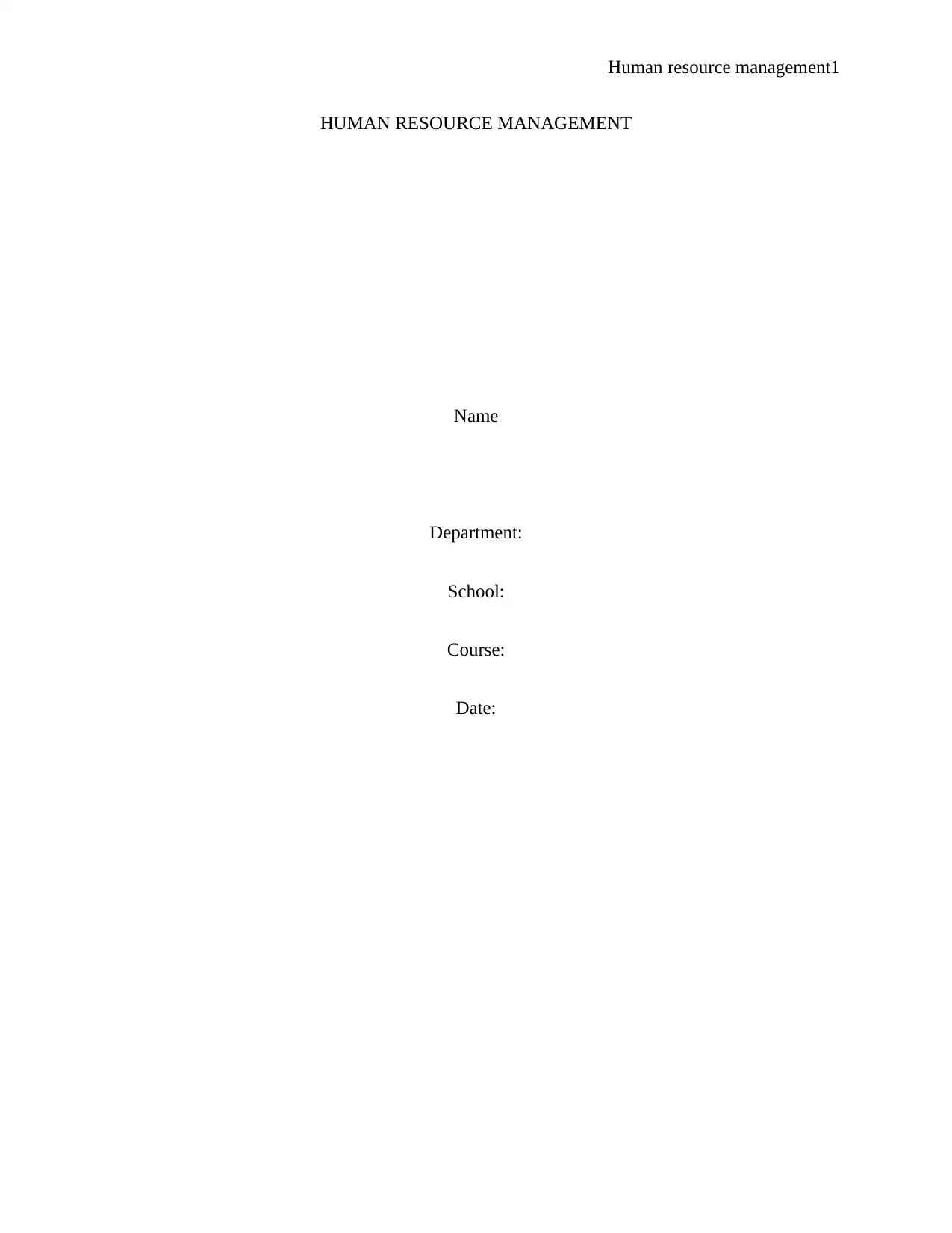
Human resource management1
HUMAN RESOURCE MANAGEMENT
Name
Department:
School:
Course:
Date:
HUMAN RESOURCE MANAGEMENT
Name
Department:
School:
Course:
Date:
Paraphrase This Document
Need a fresh take? Get an instant paraphrase of this document with our AI Paraphraser
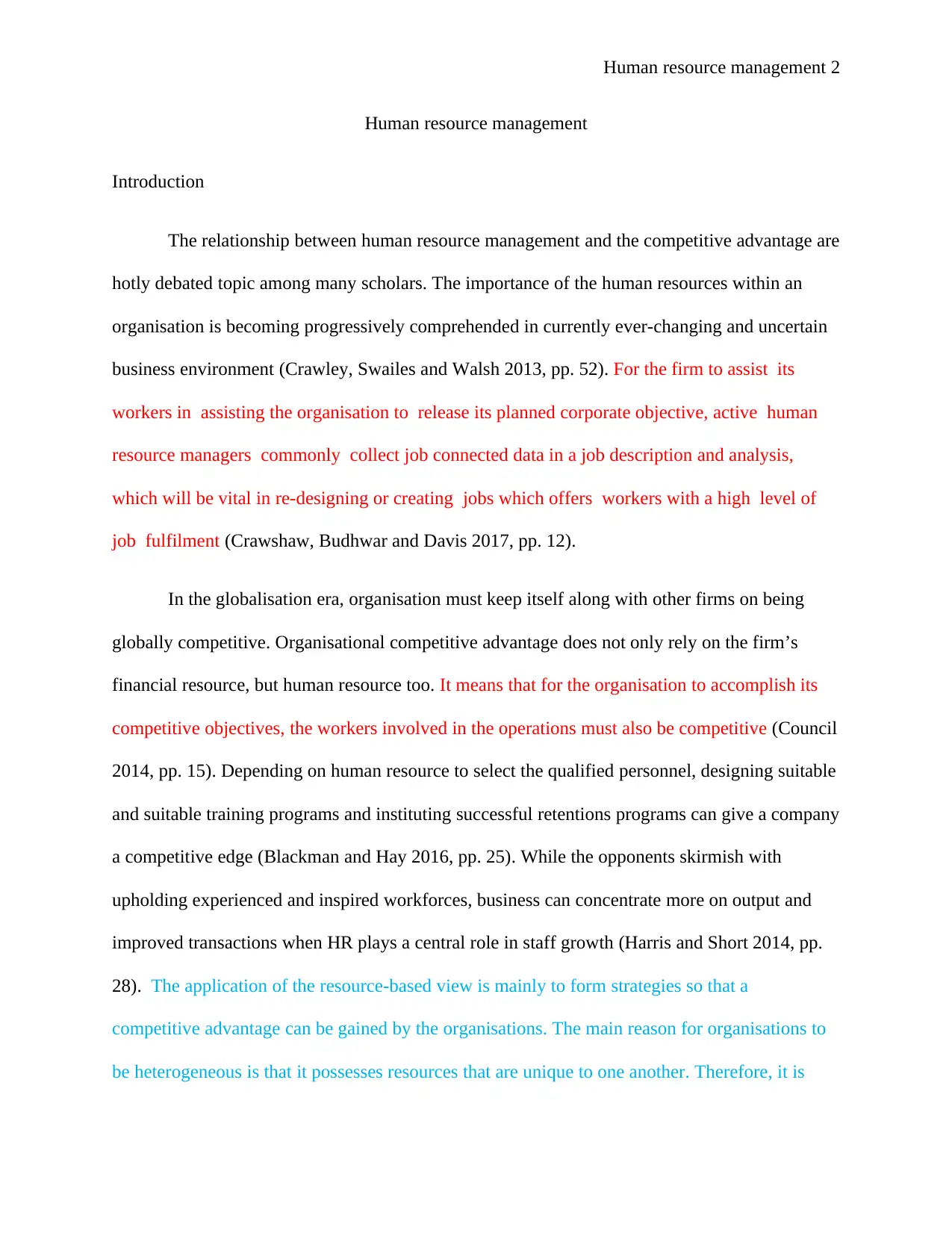
Human resource management 2
Human resource management
Introduction
The relationship between human resource management and the competitive advantage are
hotly debated topic among many scholars. The importance of the human resources within an
organisation is becoming progressively comprehended in currently ever-changing and uncertain
business environment (Crawley, Swailes and Walsh 2013, pp. 52). For the firm to assist its
workers in assisting the organisation to release its planned corporate objective, active human
resource managers commonly collect job connected data in a job description and analysis,
which will be vital in re-designing or creating jobs which offers workers with a high level of
job fulfilment (Crawshaw, Budhwar and Davis 2017, pp. 12).
In the globalisation era, organisation must keep itself along with other firms on being
globally competitive. Organisational competitive advantage does not only rely on the firm’s
financial resource, but human resource too. It means that for the organisation to accomplish its
competitive objectives, the workers involved in the operations must also be competitive (Council
2014, pp. 15). Depending on human resource to select the qualified personnel, designing suitable
and suitable training programs and instituting successful retentions programs can give a company
a competitive edge (Blackman and Hay 2016, pp. 25). While the opponents skirmish with
upholding experienced and inspired workforces, business can concentrate more on output and
improved transactions when HR plays a central role in staff growth (Harris and Short 2014, pp.
28). The application of the resource-based view is mainly to form strategies so that a
competitive advantage can be gained by the organisations. The main reason for organisations to
be heterogeneous is that it possesses resources that are unique to one another. Therefore, it is
Human resource management
Introduction
The relationship between human resource management and the competitive advantage are
hotly debated topic among many scholars. The importance of the human resources within an
organisation is becoming progressively comprehended in currently ever-changing and uncertain
business environment (Crawley, Swailes and Walsh 2013, pp. 52). For the firm to assist its
workers in assisting the organisation to release its planned corporate objective, active human
resource managers commonly collect job connected data in a job description and analysis,
which will be vital in re-designing or creating jobs which offers workers with a high level of
job fulfilment (Crawshaw, Budhwar and Davis 2017, pp. 12).
In the globalisation era, organisation must keep itself along with other firms on being
globally competitive. Organisational competitive advantage does not only rely on the firm’s
financial resource, but human resource too. It means that for the organisation to accomplish its
competitive objectives, the workers involved in the operations must also be competitive (Council
2014, pp. 15). Depending on human resource to select the qualified personnel, designing suitable
and suitable training programs and instituting successful retentions programs can give a company
a competitive edge (Blackman and Hay 2016, pp. 25). While the opponents skirmish with
upholding experienced and inspired workforces, business can concentrate more on output and
improved transactions when HR plays a central role in staff growth (Harris and Short 2014, pp.
28). The application of the resource-based view is mainly to form strategies so that a
competitive advantage can be gained by the organisations. The main reason for organisations to
be heterogeneous is that it possesses resources that are unique to one another. Therefore, it is
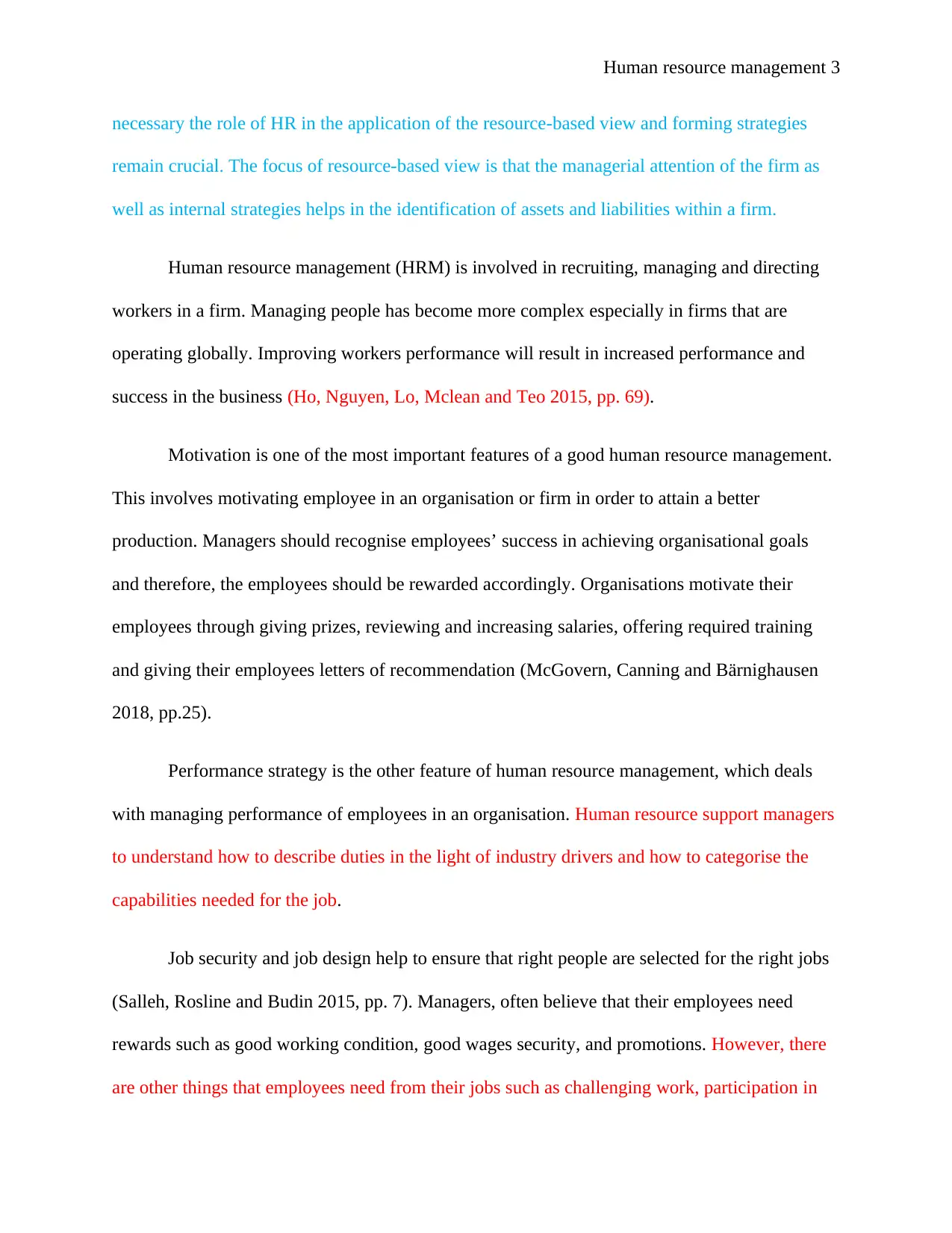
Human resource management 3
necessary the role of HR in the application of the resource-based view and forming strategies
remain crucial. The focus of resource-based view is that the managerial attention of the firm as
well as internal strategies helps in the identification of assets and liabilities within a firm.
Human resource management (HRM) is involved in recruiting, managing and directing
workers in a firm. Managing people has become more complex especially in firms that are
operating globally. Improving workers performance will result in increased performance and
success in the business (Ho, Nguyen, Lo, Mclean and Teo 2015, pp. 69).
Motivation is one of the most important features of a good human resource management.
This involves motivating employee in an organisation or firm in order to attain a better
production. Managers should recognise employees’ success in achieving organisational goals
and therefore, the employees should be rewarded accordingly. Organisations motivate their
employees through giving prizes, reviewing and increasing salaries, offering required training
and giving their employees letters of recommendation (McGovern, Canning and Bärnighausen
2018, pp.25).
Performance strategy is the other feature of human resource management, which deals
with managing performance of employees in an organisation. Human resource support managers
to understand how to describe duties in the light of industry drivers and how to categorise the
capabilities needed for the job.
Job security and job design help to ensure that right people are selected for the right jobs
(Salleh, Rosline and Budin 2015, pp. 7). Managers, often believe that their employees need
rewards such as good working condition, good wages security, and promotions. However, there
are other things that employees need from their jobs such as challenging work, participation in
necessary the role of HR in the application of the resource-based view and forming strategies
remain crucial. The focus of resource-based view is that the managerial attention of the firm as
well as internal strategies helps in the identification of assets and liabilities within a firm.
Human resource management (HRM) is involved in recruiting, managing and directing
workers in a firm. Managing people has become more complex especially in firms that are
operating globally. Improving workers performance will result in increased performance and
success in the business (Ho, Nguyen, Lo, Mclean and Teo 2015, pp. 69).
Motivation is one of the most important features of a good human resource management.
This involves motivating employee in an organisation or firm in order to attain a better
production. Managers should recognise employees’ success in achieving organisational goals
and therefore, the employees should be rewarded accordingly. Organisations motivate their
employees through giving prizes, reviewing and increasing salaries, offering required training
and giving their employees letters of recommendation (McGovern, Canning and Bärnighausen
2018, pp.25).
Performance strategy is the other feature of human resource management, which deals
with managing performance of employees in an organisation. Human resource support managers
to understand how to describe duties in the light of industry drivers and how to categorise the
capabilities needed for the job.
Job security and job design help to ensure that right people are selected for the right jobs
(Salleh, Rosline and Budin 2015, pp. 7). Managers, often believe that their employees need
rewards such as good working condition, good wages security, and promotions. However, there
are other things that employees need from their jobs such as challenging work, participation in
⊘ This is a preview!⊘
Do you want full access?
Subscribe today to unlock all pages.

Trusted by 1+ million students worldwide
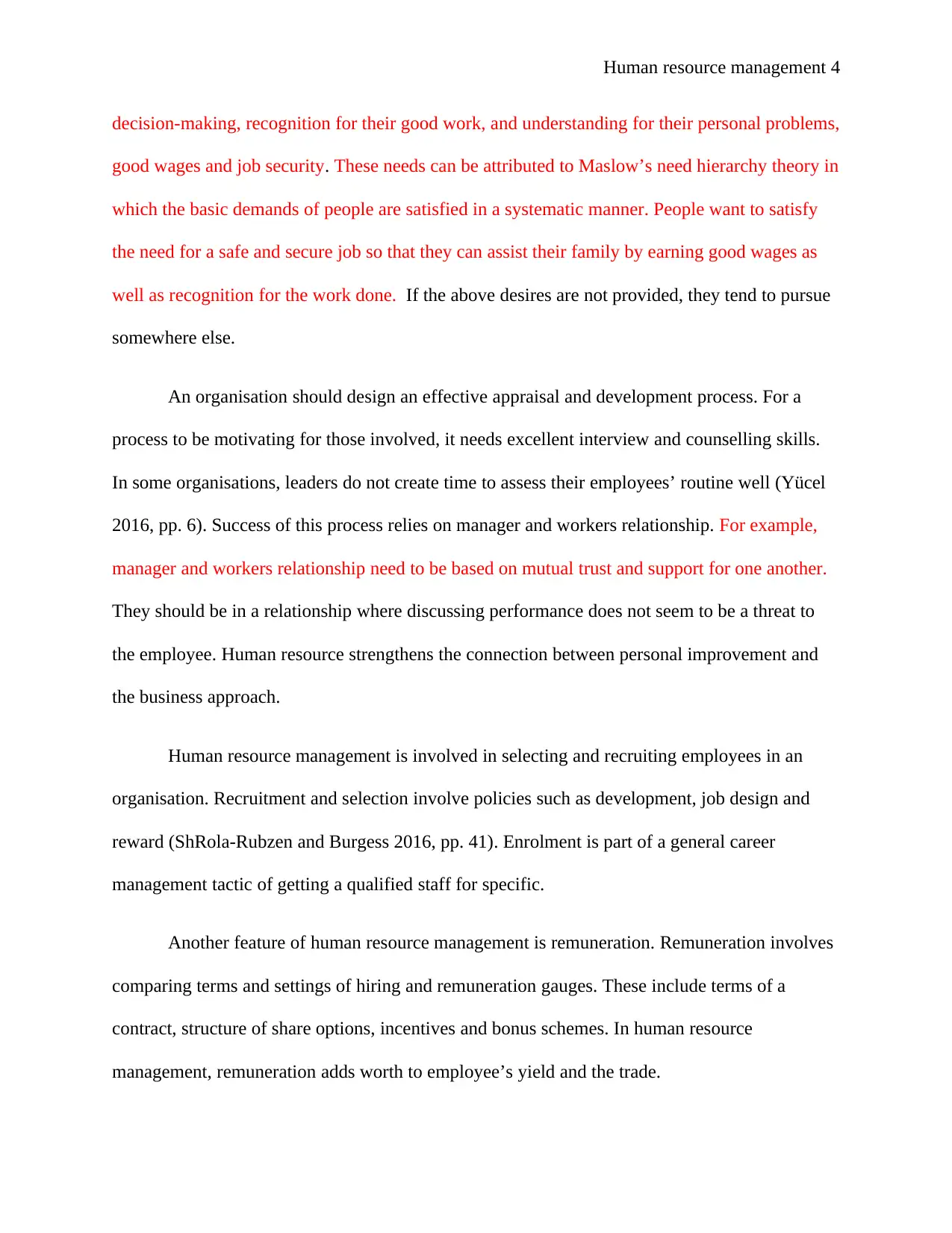
Human resource management 4
decision-making, recognition for their good work, and understanding for their personal problems,
good wages and job security. These needs can be attributed to Maslow’s need hierarchy theory in
which the basic demands of people are satisfied in a systematic manner. People want to satisfy
the need for a safe and secure job so that they can assist their family by earning good wages as
well as recognition for the work done. If the above desires are not provided, they tend to pursue
somewhere else.
An organisation should design an effective appraisal and development process. For a
process to be motivating for those involved, it needs excellent interview and counselling skills.
In some organisations, leaders do not create time to assess their employees’ routine well (Yücel
2016, pp. 6). Success of this process relies on manager and workers relationship. For example,
manager and workers relationship need to be based on mutual trust and support for one another.
They should be in a relationship where discussing performance does not seem to be a threat to
the employee. Human resource strengthens the connection between personal improvement and
the business approach.
Human resource management is involved in selecting and recruiting employees in an
organisation. Recruitment and selection involve policies such as development, job design and
reward (ShRola-Rubzen and Burgess 2016, pp. 41). Enrolment is part of a general career
management tactic of getting a qualified staff for specific.
Another feature of human resource management is remuneration. Remuneration involves
comparing terms and settings of hiring and remuneration gauges. These include terms of a
contract, structure of share options, incentives and bonus schemes. In human resource
management, remuneration adds worth to employee’s yield and the trade.
decision-making, recognition for their good work, and understanding for their personal problems,
good wages and job security. These needs can be attributed to Maslow’s need hierarchy theory in
which the basic demands of people are satisfied in a systematic manner. People want to satisfy
the need for a safe and secure job so that they can assist their family by earning good wages as
well as recognition for the work done. If the above desires are not provided, they tend to pursue
somewhere else.
An organisation should design an effective appraisal and development process. For a
process to be motivating for those involved, it needs excellent interview and counselling skills.
In some organisations, leaders do not create time to assess their employees’ routine well (Yücel
2016, pp. 6). Success of this process relies on manager and workers relationship. For example,
manager and workers relationship need to be based on mutual trust and support for one another.
They should be in a relationship where discussing performance does not seem to be a threat to
the employee. Human resource strengthens the connection between personal improvement and
the business approach.
Human resource management is involved in selecting and recruiting employees in an
organisation. Recruitment and selection involve policies such as development, job design and
reward (ShRola-Rubzen and Burgess 2016, pp. 41). Enrolment is part of a general career
management tactic of getting a qualified staff for specific.
Another feature of human resource management is remuneration. Remuneration involves
comparing terms and settings of hiring and remuneration gauges. These include terms of a
contract, structure of share options, incentives and bonus schemes. In human resource
management, remuneration adds worth to employee’s yield and the trade.
Paraphrase This Document
Need a fresh take? Get an instant paraphrase of this document with our AI Paraphraser
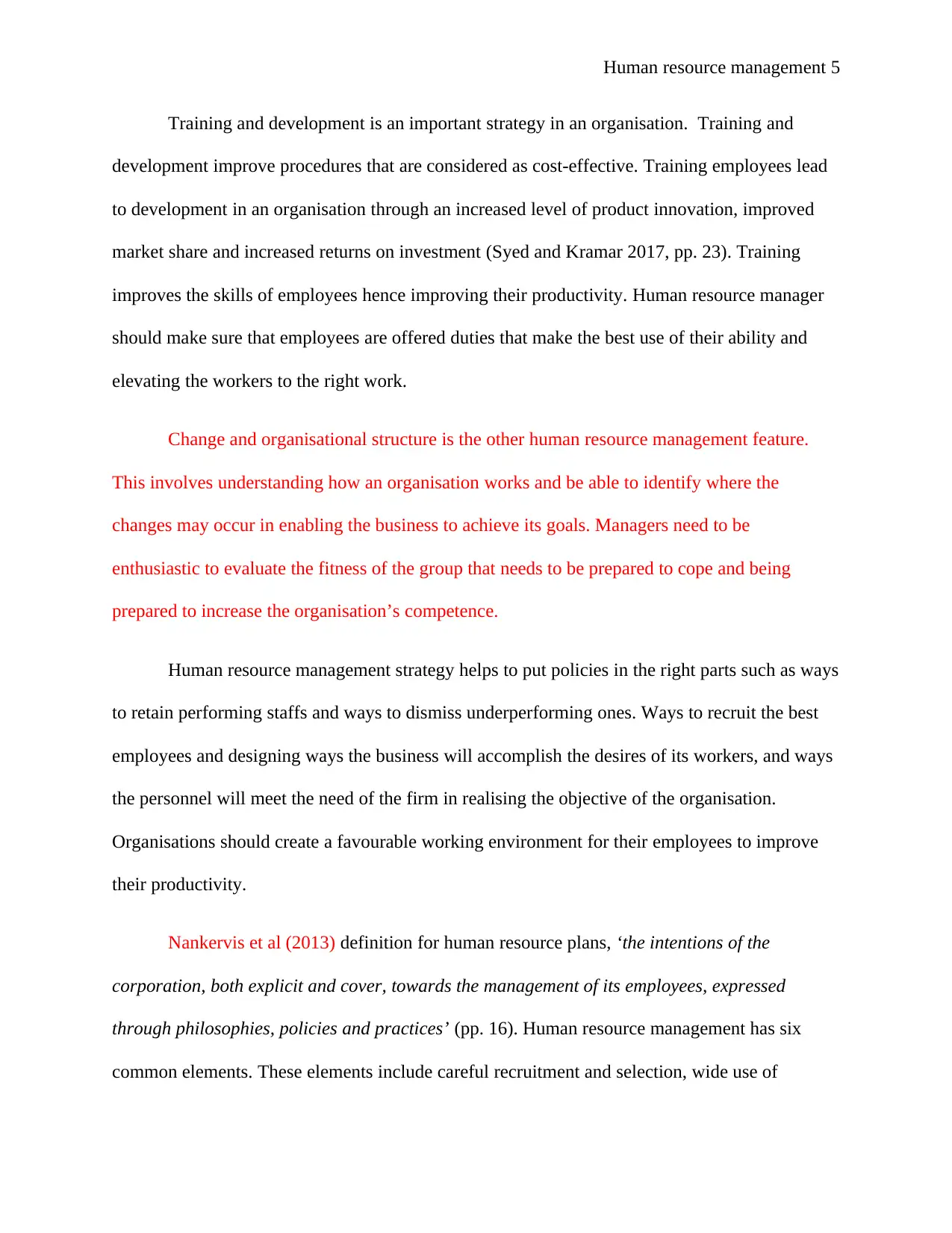
Human resource management 5
Training and development is an important strategy in an organisation. Training and
development improve procedures that are considered as cost-effective. Training employees lead
to development in an organisation through an increased level of product innovation, improved
market share and increased returns on investment (Syed and Kramar 2017, pp. 23). Training
improves the skills of employees hence improving their productivity. Human resource manager
should make sure that employees are offered duties that make the best use of their ability and
elevating the workers to the right work.
Change and organisational structure is the other human resource management feature.
This involves understanding how an organisation works and be able to identify where the
changes may occur in enabling the business to achieve its goals. Managers need to be
enthusiastic to evaluate the fitness of the group that needs to be prepared to cope and being
prepared to increase the organisation’s competence.
Human resource management strategy helps to put policies in the right parts such as ways
to retain performing staffs and ways to dismiss underperforming ones. Ways to recruit the best
employees and designing ways the business will accomplish the desires of its workers, and ways
the personnel will meet the need of the firm in realising the objective of the organisation.
Organisations should create a favourable working environment for their employees to improve
their productivity.
Nankervis et al (2013) definition for human resource plans, ‘the intentions of the
corporation, both explicit and cover, towards the management of its employees, expressed
through philosophies, policies and practices’ (pp. 16). Human resource management has six
common elements. These elements include careful recruitment and selection, wide use of
Training and development is an important strategy in an organisation. Training and
development improve procedures that are considered as cost-effective. Training employees lead
to development in an organisation through an increased level of product innovation, improved
market share and increased returns on investment (Syed and Kramar 2017, pp. 23). Training
improves the skills of employees hence improving their productivity. Human resource manager
should make sure that employees are offered duties that make the best use of their ability and
elevating the workers to the right work.
Change and organisational structure is the other human resource management feature.
This involves understanding how an organisation works and be able to identify where the
changes may occur in enabling the business to achieve its goals. Managers need to be
enthusiastic to evaluate the fitness of the group that needs to be prepared to cope and being
prepared to increase the organisation’s competence.
Human resource management strategy helps to put policies in the right parts such as ways
to retain performing staffs and ways to dismiss underperforming ones. Ways to recruit the best
employees and designing ways the business will accomplish the desires of its workers, and ways
the personnel will meet the need of the firm in realising the objective of the organisation.
Organisations should create a favourable working environment for their employees to improve
their productivity.
Nankervis et al (2013) definition for human resource plans, ‘the intentions of the
corporation, both explicit and cover, towards the management of its employees, expressed
through philosophies, policies and practices’ (pp. 16). Human resource management has six
common elements. These elements include careful recruitment and selection, wide use of
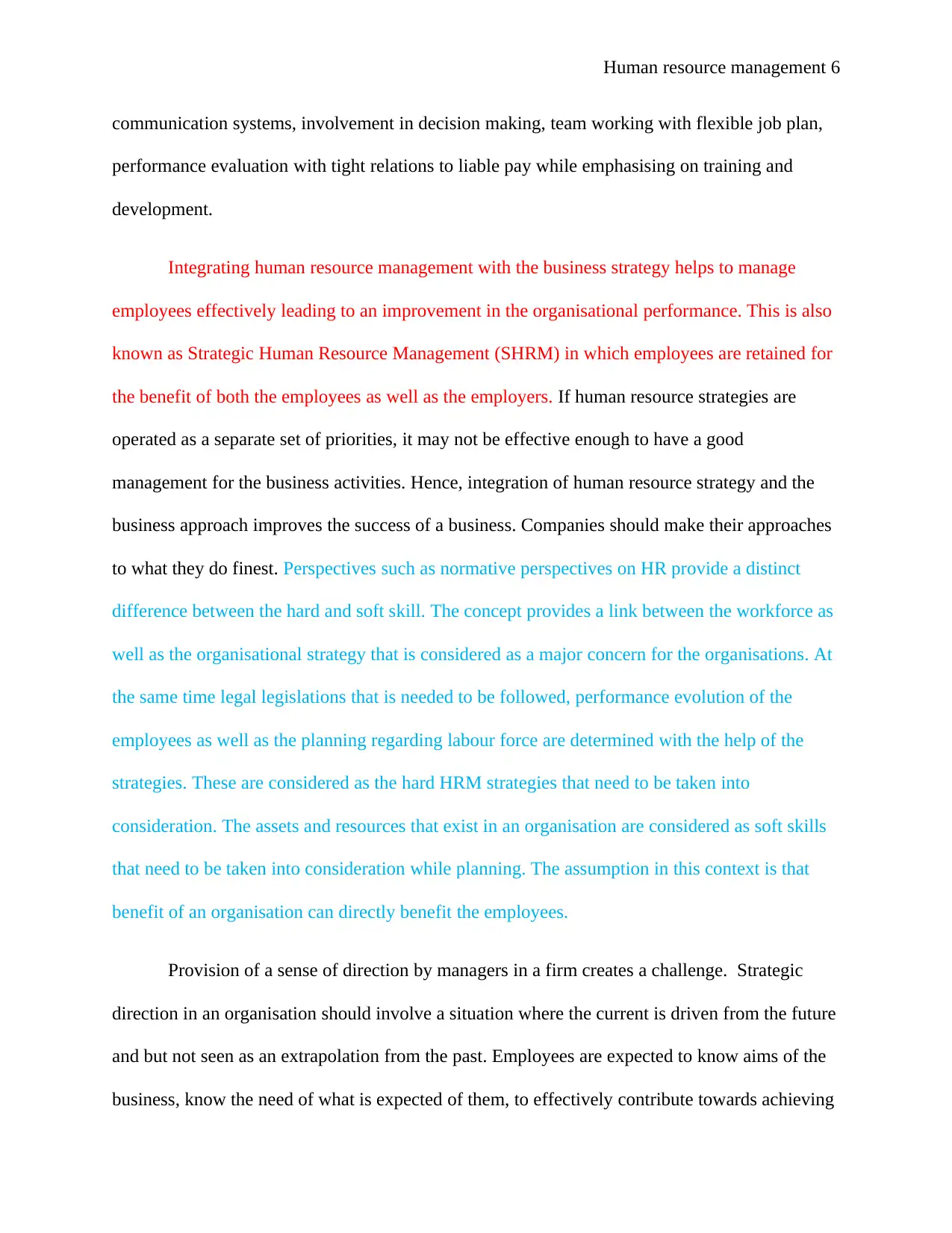
Human resource management 6
communication systems, involvement in decision making, team working with flexible job plan,
performance evaluation with tight relations to liable pay while emphasising on training and
development.
Integrating human resource management with the business strategy helps to manage
employees effectively leading to an improvement in the organisational performance. This is also
known as Strategic Human Resource Management (SHRM) in which employees are retained for
the benefit of both the employees as well as the employers. If human resource strategies are
operated as a separate set of priorities, it may not be effective enough to have a good
management for the business activities. Hence, integration of human resource strategy and the
business approach improves the success of a business. Companies should make their approaches
to what they do finest. Perspectives such as normative perspectives on HR provide a distinct
difference between the hard and soft skill. The concept provides a link between the workforce as
well as the organisational strategy that is considered as a major concern for the organisations. At
the same time legal legislations that is needed to be followed, performance evolution of the
employees as well as the planning regarding labour force are determined with the help of the
strategies. These are considered as the hard HRM strategies that need to be taken into
consideration. The assets and resources that exist in an organisation are considered as soft skills
that need to be taken into consideration while planning. The assumption in this context is that
benefit of an organisation can directly benefit the employees.
Provision of a sense of direction by managers in a firm creates a challenge. Strategic
direction in an organisation should involve a situation where the current is driven from the future
and but not seen as an extrapolation from the past. Employees are expected to know aims of the
business, know the need of what is expected of them, to effectively contribute towards achieving
communication systems, involvement in decision making, team working with flexible job plan,
performance evaluation with tight relations to liable pay while emphasising on training and
development.
Integrating human resource management with the business strategy helps to manage
employees effectively leading to an improvement in the organisational performance. This is also
known as Strategic Human Resource Management (SHRM) in which employees are retained for
the benefit of both the employees as well as the employers. If human resource strategies are
operated as a separate set of priorities, it may not be effective enough to have a good
management for the business activities. Hence, integration of human resource strategy and the
business approach improves the success of a business. Companies should make their approaches
to what they do finest. Perspectives such as normative perspectives on HR provide a distinct
difference between the hard and soft skill. The concept provides a link between the workforce as
well as the organisational strategy that is considered as a major concern for the organisations. At
the same time legal legislations that is needed to be followed, performance evolution of the
employees as well as the planning regarding labour force are determined with the help of the
strategies. These are considered as the hard HRM strategies that need to be taken into
consideration. The assets and resources that exist in an organisation are considered as soft skills
that need to be taken into consideration while planning. The assumption in this context is that
benefit of an organisation can directly benefit the employees.
Provision of a sense of direction by managers in a firm creates a challenge. Strategic
direction in an organisation should involve a situation where the current is driven from the future
and but not seen as an extrapolation from the past. Employees are expected to know aims of the
business, know the need of what is expected of them, to effectively contribute towards achieving
⊘ This is a preview!⊘
Do you want full access?
Subscribe today to unlock all pages.

Trusted by 1+ million students worldwide
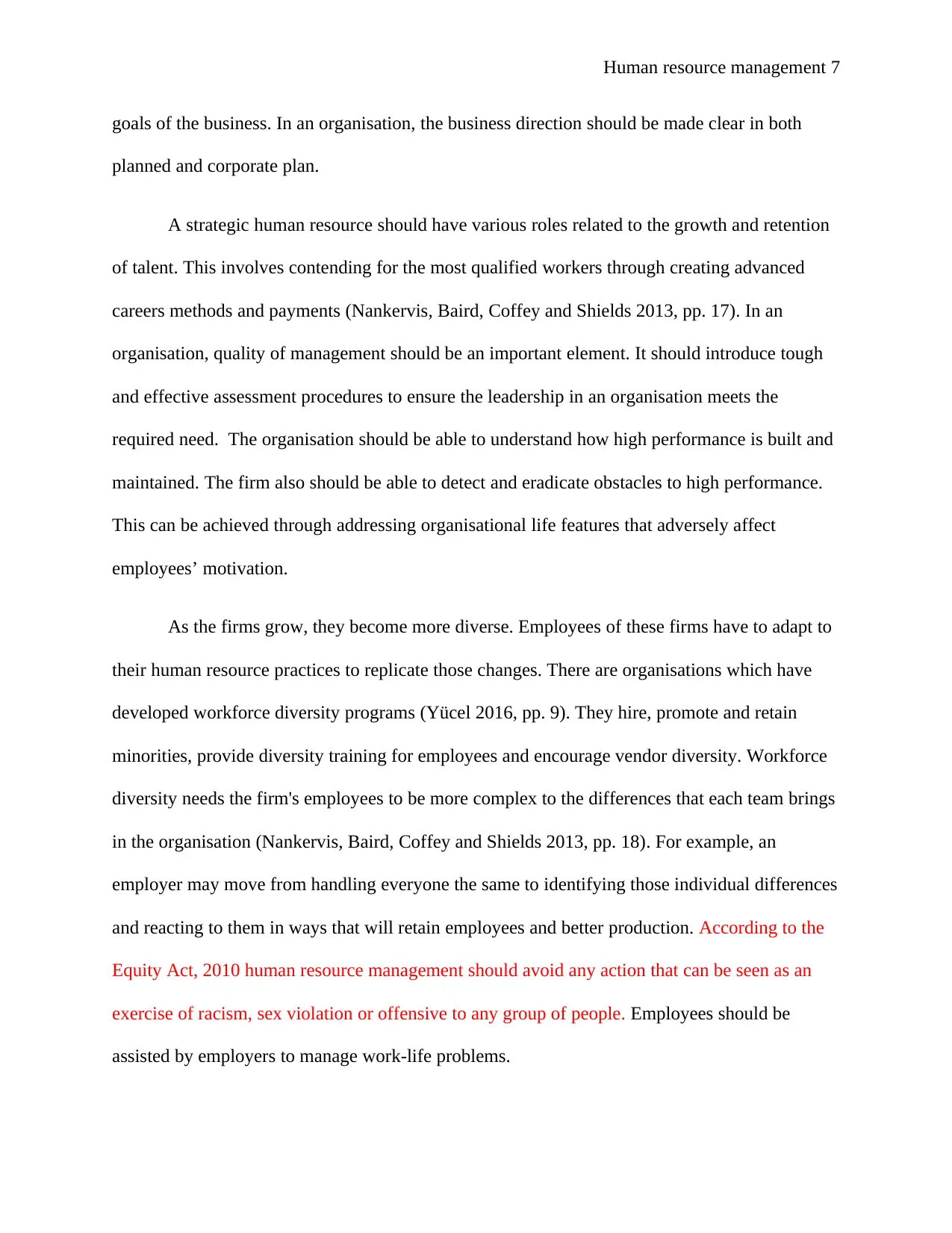
Human resource management 7
goals of the business. In an organisation, the business direction should be made clear in both
planned and corporate plan.
A strategic human resource should have various roles related to the growth and retention
of talent. This involves contending for the most qualified workers through creating advanced
careers methods and payments (Nankervis, Baird, Coffey and Shields 2013, pp. 17). In an
organisation, quality of management should be an important element. It should introduce tough
and effective assessment procedures to ensure the leadership in an organisation meets the
required need. The organisation should be able to understand how high performance is built and
maintained. The firm also should be able to detect and eradicate obstacles to high performance.
This can be achieved through addressing organisational life features that adversely affect
employees’ motivation.
As the firms grow, they become more diverse. Employees of these firms have to adapt to
their human resource practices to replicate those changes. There are organisations which have
developed workforce diversity programs (Yücel 2016, pp. 9). They hire, promote and retain
minorities, provide diversity training for employees and encourage vendor diversity. Workforce
diversity needs the firm's employees to be more complex to the differences that each team brings
in the organisation (Nankervis, Baird, Coffey and Shields 2013, pp. 18). For example, an
employer may move from handling everyone the same to identifying those individual differences
and reacting to them in ways that will retain employees and better production. According to the
Equity Act, 2010 human resource management should avoid any action that can be seen as an
exercise of racism, sex violation or offensive to any group of people. Employees should be
assisted by employers to manage work-life problems.
goals of the business. In an organisation, the business direction should be made clear in both
planned and corporate plan.
A strategic human resource should have various roles related to the growth and retention
of talent. This involves contending for the most qualified workers through creating advanced
careers methods and payments (Nankervis, Baird, Coffey and Shields 2013, pp. 17). In an
organisation, quality of management should be an important element. It should introduce tough
and effective assessment procedures to ensure the leadership in an organisation meets the
required need. The organisation should be able to understand how high performance is built and
maintained. The firm also should be able to detect and eradicate obstacles to high performance.
This can be achieved through addressing organisational life features that adversely affect
employees’ motivation.
As the firms grow, they become more diverse. Employees of these firms have to adapt to
their human resource practices to replicate those changes. There are organisations which have
developed workforce diversity programs (Yücel 2016, pp. 9). They hire, promote and retain
minorities, provide diversity training for employees and encourage vendor diversity. Workforce
diversity needs the firm's employees to be more complex to the differences that each team brings
in the organisation (Nankervis, Baird, Coffey and Shields 2013, pp. 18). For example, an
employer may move from handling everyone the same to identifying those individual differences
and reacting to them in ways that will retain employees and better production. According to the
Equity Act, 2010 human resource management should avoid any action that can be seen as an
exercise of racism, sex violation or offensive to any group of people. Employees should be
assisted by employers to manage work-life problems.
Paraphrase This Document
Need a fresh take? Get an instant paraphrase of this document with our AI Paraphraser
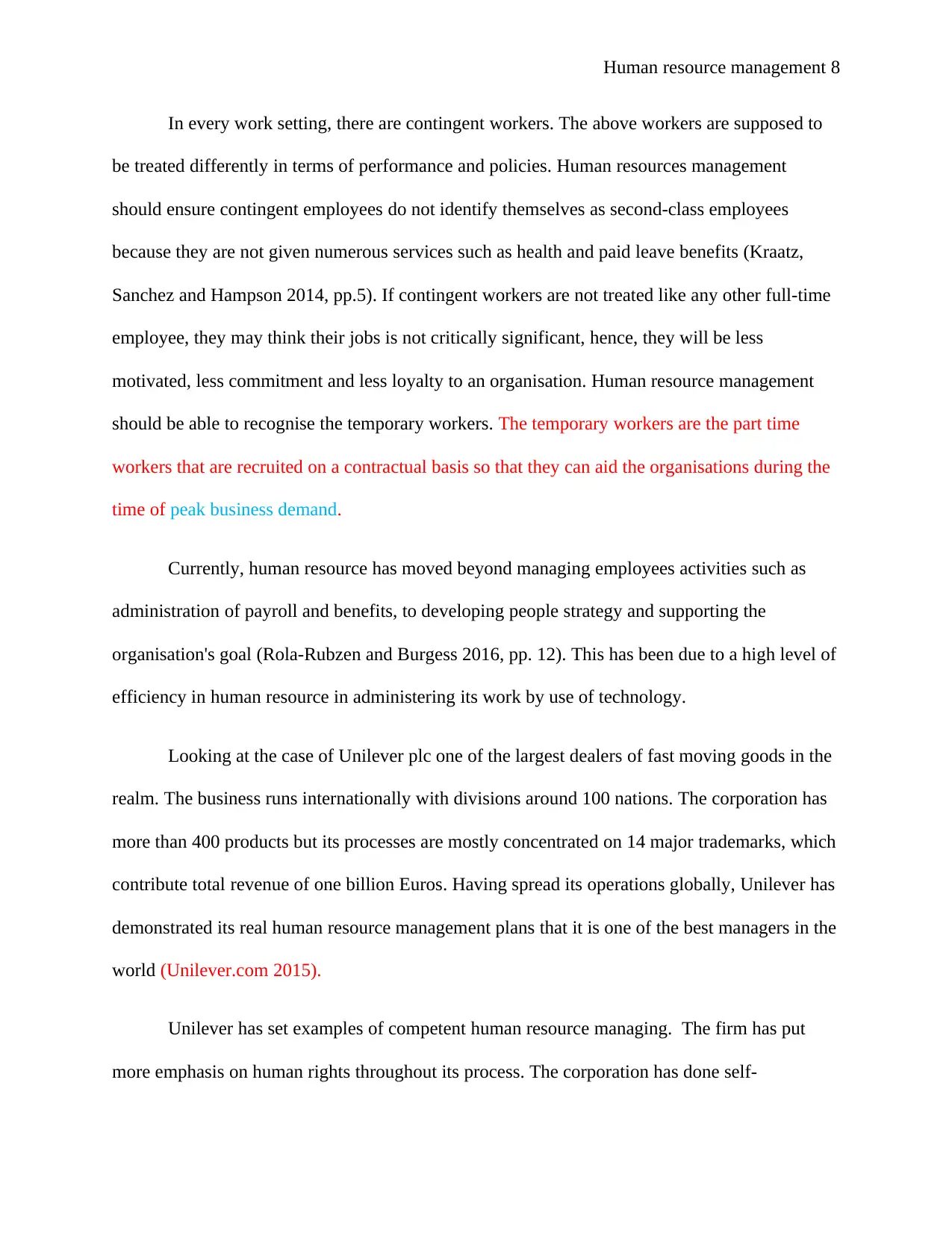
Human resource management 8
In every work setting, there are contingent workers. The above workers are supposed to
be treated differently in terms of performance and policies. Human resources management
should ensure contingent employees do not identify themselves as second-class employees
because they are not given numerous services such as health and paid leave benefits (Kraatz,
Sanchez and Hampson 2014, pp.5). If contingent workers are not treated like any other full-time
employee, they may think their jobs is not critically significant, hence, they will be less
motivated, less commitment and less loyalty to an organisation. Human resource management
should be able to recognise the temporary workers. The temporary workers are the part time
workers that are recruited on a contractual basis so that they can aid the organisations during the
time of peak business demand.
Currently, human resource has moved beyond managing employees activities such as
administration of payroll and benefits, to developing people strategy and supporting the
organisation's goal (Rola-Rubzen and Burgess 2016, pp. 12). This has been due to a high level of
efficiency in human resource in administering its work by use of technology.
Looking at the case of Unilever plc one of the largest dealers of fast moving goods in the
realm. The business runs internationally with divisions around 100 nations. The corporation has
more than 400 products but its processes are mostly concentrated on 14 major trademarks, which
contribute total revenue of one billion Euros. Having spread its operations globally, Unilever has
demonstrated its real human resource management plans that it is one of the best managers in the
world (Unilever.com 2015).
Unilever has set examples of competent human resource managing. The firm has put
more emphasis on human rights throughout its process. The corporation has done self-
In every work setting, there are contingent workers. The above workers are supposed to
be treated differently in terms of performance and policies. Human resources management
should ensure contingent employees do not identify themselves as second-class employees
because they are not given numerous services such as health and paid leave benefits (Kraatz,
Sanchez and Hampson 2014, pp.5). If contingent workers are not treated like any other full-time
employee, they may think their jobs is not critically significant, hence, they will be less
motivated, less commitment and less loyalty to an organisation. Human resource management
should be able to recognise the temporary workers. The temporary workers are the part time
workers that are recruited on a contractual basis so that they can aid the organisations during the
time of peak business demand.
Currently, human resource has moved beyond managing employees activities such as
administration of payroll and benefits, to developing people strategy and supporting the
organisation's goal (Rola-Rubzen and Burgess 2016, pp. 12). This has been due to a high level of
efficiency in human resource in administering its work by use of technology.
Looking at the case of Unilever plc one of the largest dealers of fast moving goods in the
realm. The business runs internationally with divisions around 100 nations. The corporation has
more than 400 products but its processes are mostly concentrated on 14 major trademarks, which
contribute total revenue of one billion Euros. Having spread its operations globally, Unilever has
demonstrated its real human resource management plans that it is one of the best managers in the
world (Unilever.com 2015).
Unilever has set examples of competent human resource managing. The firm has put
more emphasis on human rights throughout its process. The corporation has done self-
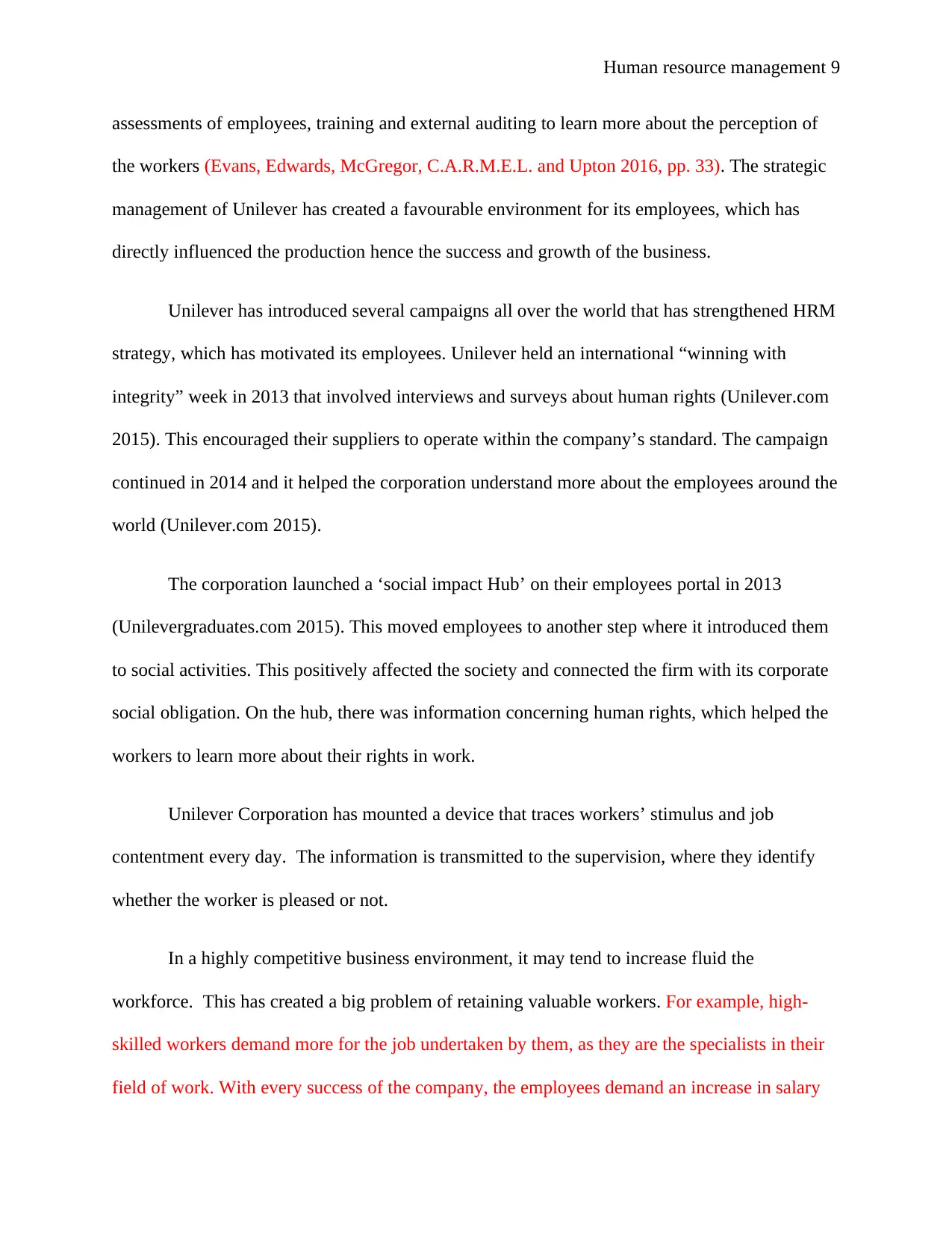
Human resource management 9
assessments of employees, training and external auditing to learn more about the perception of
the workers (Evans, Edwards, McGregor, C.A.R.M.E.L. and Upton 2016, pp. 33). The strategic
management of Unilever has created a favourable environment for its employees, which has
directly influenced the production hence the success and growth of the business.
Unilever has introduced several campaigns all over the world that has strengthened HRM
strategy, which has motivated its employees. Unilever held an international “winning with
integrity” week in 2013 that involved interviews and surveys about human rights (Unilever.com
2015). This encouraged their suppliers to operate within the company’s standard. The campaign
continued in 2014 and it helped the corporation understand more about the employees around the
world (Unilever.com 2015).
The corporation launched a ‘social impact Hub’ on their employees portal in 2013
(Unilevergraduates.com 2015). This moved employees to another step where it introduced them
to social activities. This positively affected the society and connected the firm with its corporate
social obligation. On the hub, there was information concerning human rights, which helped the
workers to learn more about their rights in work.
Unilever Corporation has mounted a device that traces workers’ stimulus and job
contentment every day. The information is transmitted to the supervision, where they identify
whether the worker is pleased or not.
In a highly competitive business environment, it may tend to increase fluid the
workforce. This has created a big problem of retaining valuable workers. For example, high-
skilled workers demand more for the job undertaken by them, as they are the specialists in their
field of work. With every success of the company, the employees demand an increase in salary
assessments of employees, training and external auditing to learn more about the perception of
the workers (Evans, Edwards, McGregor, C.A.R.M.E.L. and Upton 2016, pp. 33). The strategic
management of Unilever has created a favourable environment for its employees, which has
directly influenced the production hence the success and growth of the business.
Unilever has introduced several campaigns all over the world that has strengthened HRM
strategy, which has motivated its employees. Unilever held an international “winning with
integrity” week in 2013 that involved interviews and surveys about human rights (Unilever.com
2015). This encouraged their suppliers to operate within the company’s standard. The campaign
continued in 2014 and it helped the corporation understand more about the employees around the
world (Unilever.com 2015).
The corporation launched a ‘social impact Hub’ on their employees portal in 2013
(Unilevergraduates.com 2015). This moved employees to another step where it introduced them
to social activities. This positively affected the society and connected the firm with its corporate
social obligation. On the hub, there was information concerning human rights, which helped the
workers to learn more about their rights in work.
Unilever Corporation has mounted a device that traces workers’ stimulus and job
contentment every day. The information is transmitted to the supervision, where they identify
whether the worker is pleased or not.
In a highly competitive business environment, it may tend to increase fluid the
workforce. This has created a big problem of retaining valuable workers. For example, high-
skilled workers demand more for the job undertaken by them, as they are the specialists in their
field of work. With every success of the company, the employees demand an increase in salary
⊘ This is a preview!⊘
Do you want full access?
Subscribe today to unlock all pages.

Trusted by 1+ million students worldwide
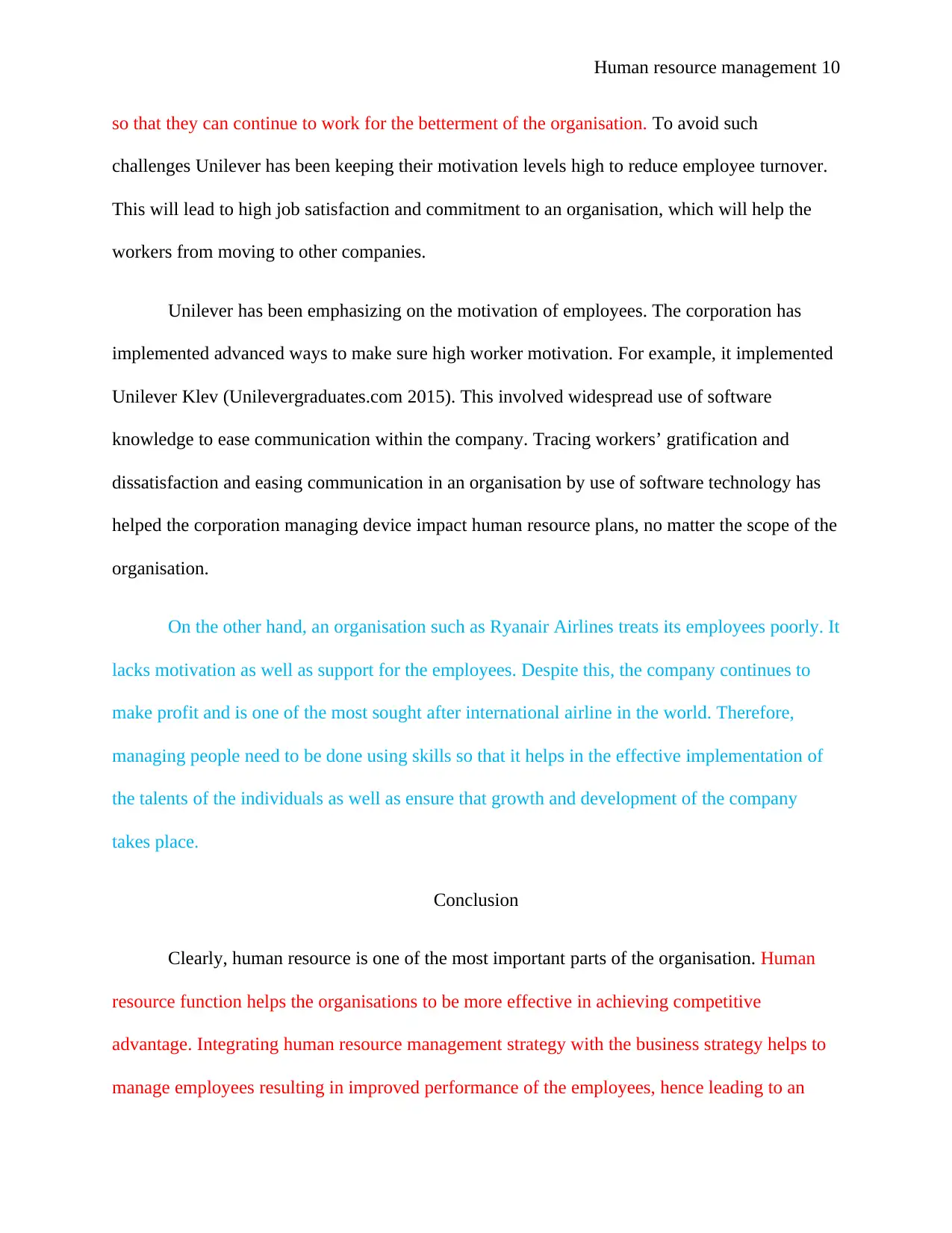
Human resource management 10
so that they can continue to work for the betterment of the organisation. To avoid such
challenges Unilever has been keeping their motivation levels high to reduce employee turnover.
This will lead to high job satisfaction and commitment to an organisation, which will help the
workers from moving to other companies.
Unilever has been emphasizing on the motivation of employees. The corporation has
implemented advanced ways to make sure high worker motivation. For example, it implemented
Unilever Klev (Unilevergraduates.com 2015). This involved widespread use of software
knowledge to ease communication within the company. Tracing workers’ gratification and
dissatisfaction and easing communication in an organisation by use of software technology has
helped the corporation managing device impact human resource plans, no matter the scope of the
organisation.
On the other hand, an organisation such as Ryanair Airlines treats its employees poorly. It
lacks motivation as well as support for the employees. Despite this, the company continues to
make profit and is one of the most sought after international airline in the world. Therefore,
managing people need to be done using skills so that it helps in the effective implementation of
the talents of the individuals as well as ensure that growth and development of the company
takes place.
Conclusion
Clearly, human resource is one of the most important parts of the organisation. Human
resource function helps the organisations to be more effective in achieving competitive
advantage. Integrating human resource management strategy with the business strategy helps to
manage employees resulting in improved performance of the employees, hence leading to an
so that they can continue to work for the betterment of the organisation. To avoid such
challenges Unilever has been keeping their motivation levels high to reduce employee turnover.
This will lead to high job satisfaction and commitment to an organisation, which will help the
workers from moving to other companies.
Unilever has been emphasizing on the motivation of employees. The corporation has
implemented advanced ways to make sure high worker motivation. For example, it implemented
Unilever Klev (Unilevergraduates.com 2015). This involved widespread use of software
knowledge to ease communication within the company. Tracing workers’ gratification and
dissatisfaction and easing communication in an organisation by use of software technology has
helped the corporation managing device impact human resource plans, no matter the scope of the
organisation.
On the other hand, an organisation such as Ryanair Airlines treats its employees poorly. It
lacks motivation as well as support for the employees. Despite this, the company continues to
make profit and is one of the most sought after international airline in the world. Therefore,
managing people need to be done using skills so that it helps in the effective implementation of
the talents of the individuals as well as ensure that growth and development of the company
takes place.
Conclusion
Clearly, human resource is one of the most important parts of the organisation. Human
resource function helps the organisations to be more effective in achieving competitive
advantage. Integrating human resource management strategy with the business strategy helps to
manage employees resulting in improved performance of the employees, hence leading to an
Paraphrase This Document
Need a fresh take? Get an instant paraphrase of this document with our AI Paraphraser
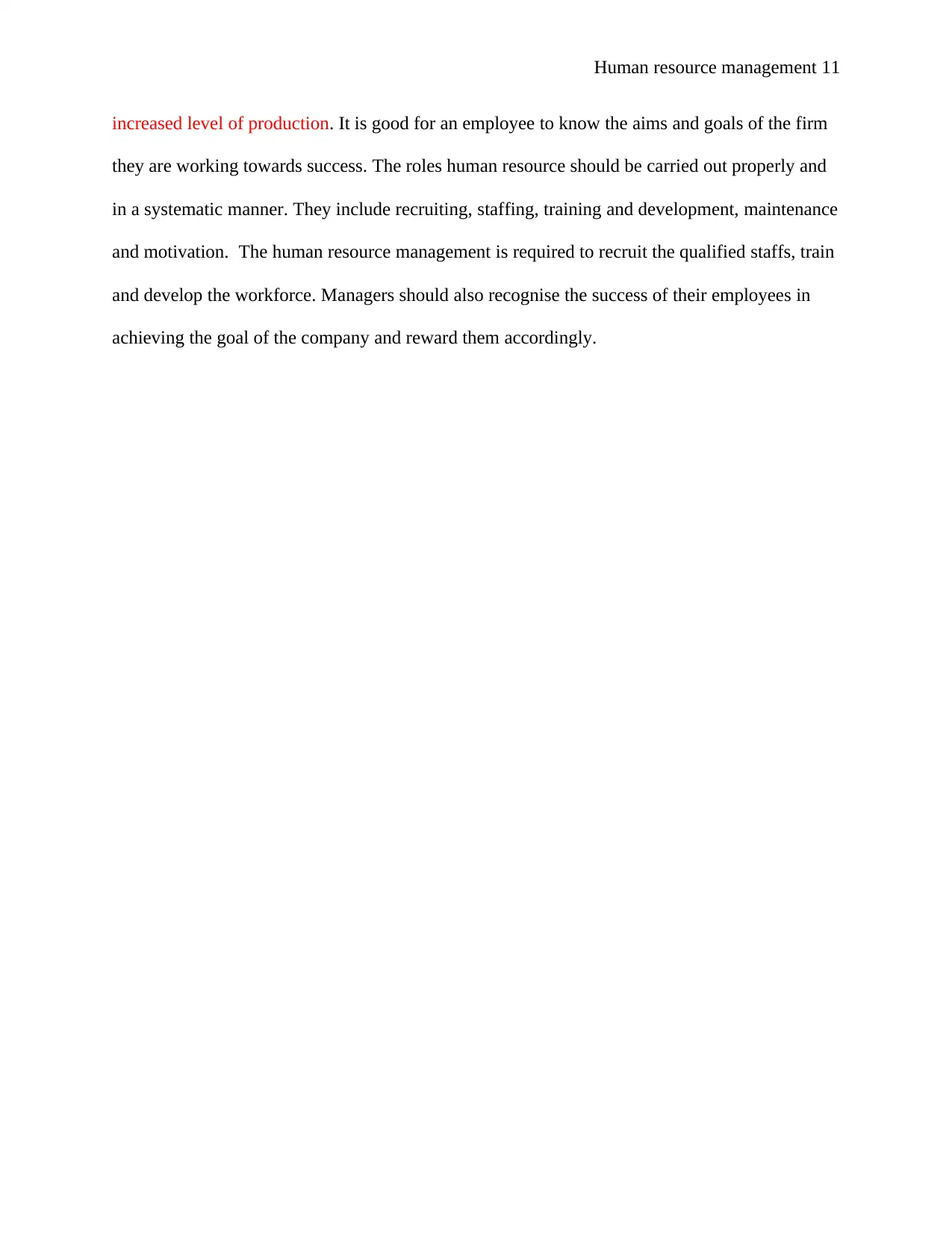
Human resource management 11
increased level of production. It is good for an employee to know the aims and goals of the firm
they are working towards success. The roles human resource should be carried out properly and
in a systematic manner. They include recruiting, staffing, training and development, maintenance
and motivation. The human resource management is required to recruit the qualified staffs, train
and develop the workforce. Managers should also recognise the success of their employees in
achieving the goal of the company and reward them accordingly.
increased level of production. It is good for an employee to know the aims and goals of the firm
they are working towards success. The roles human resource should be carried out properly and
in a systematic manner. They include recruiting, staffing, training and development, maintenance
and motivation. The human resource management is required to recruit the qualified staffs, train
and develop the workforce. Managers should also recognise the success of their employees in
achieving the goal of the company and reward them accordingly.
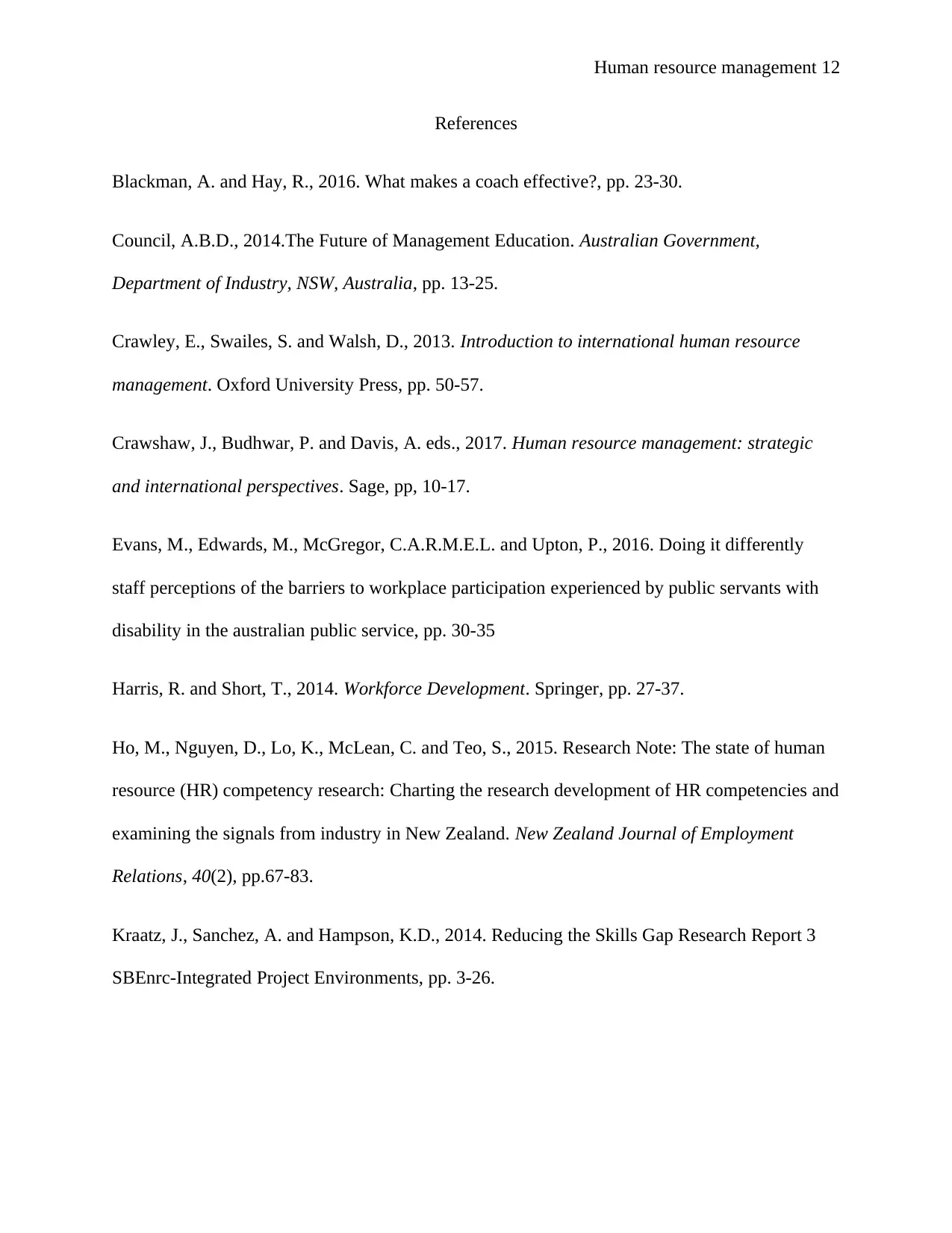
Human resource management 12
References
Blackman, A. and Hay, R., 2016. What makes a coach effective?, pp. 23-30.
Council, A.B.D., 2014.The Future of Management Education. Australian Government,
Department of Industry, NSW, Australia, pp. 13-25.
Crawley, E., Swailes, S. and Walsh, D., 2013. Introduction to international human resource
management. Oxford University Press, pp. 50-57.
Crawshaw, J., Budhwar, P. and Davis, A. eds., 2017. Human resource management: strategic
and international perspectives. Sage, pp, 10-17.
Evans, M., Edwards, M., McGregor, C.A.R.M.E.L. and Upton, P., 2016. Doing it differently
staff perceptions of the barriers to workplace participation experienced by public servants with
disability in the australian public service, pp. 30-35
Harris, R. and Short, T., 2014. Workforce Development. Springer, pp. 27-37.
Ho, M., Nguyen, D., Lo, K., McLean, C. and Teo, S., 2015. Research Note: The state of human
resource (HR) competency research: Charting the research development of HR competencies and
examining the signals from industry in New Zealand. New Zealand Journal of Employment
Relations, 40(2), pp.67-83.
Kraatz, J., Sanchez, A. and Hampson, K.D., 2014. Reducing the Skills Gap Research Report 3
SBEnrc-Integrated Project Environments, pp. 3-26.
References
Blackman, A. and Hay, R., 2016. What makes a coach effective?, pp. 23-30.
Council, A.B.D., 2014.The Future of Management Education. Australian Government,
Department of Industry, NSW, Australia, pp. 13-25.
Crawley, E., Swailes, S. and Walsh, D., 2013. Introduction to international human resource
management. Oxford University Press, pp. 50-57.
Crawshaw, J., Budhwar, P. and Davis, A. eds., 2017. Human resource management: strategic
and international perspectives. Sage, pp, 10-17.
Evans, M., Edwards, M., McGregor, C.A.R.M.E.L. and Upton, P., 2016. Doing it differently
staff perceptions of the barriers to workplace participation experienced by public servants with
disability in the australian public service, pp. 30-35
Harris, R. and Short, T., 2014. Workforce Development. Springer, pp. 27-37.
Ho, M., Nguyen, D., Lo, K., McLean, C. and Teo, S., 2015. Research Note: The state of human
resource (HR) competency research: Charting the research development of HR competencies and
examining the signals from industry in New Zealand. New Zealand Journal of Employment
Relations, 40(2), pp.67-83.
Kraatz, J., Sanchez, A. and Hampson, K.D., 2014. Reducing the Skills Gap Research Report 3
SBEnrc-Integrated Project Environments, pp. 3-26.
⊘ This is a preview!⊘
Do you want full access?
Subscribe today to unlock all pages.

Trusted by 1+ million students worldwide
1 out of 13
Related Documents
Your All-in-One AI-Powered Toolkit for Academic Success.
+13062052269
info@desklib.com
Available 24*7 on WhatsApp / Email
![[object Object]](/_next/static/media/star-bottom.7253800d.svg)
Unlock your academic potential
Copyright © 2020–2025 A2Z Services. All Rights Reserved. Developed and managed by ZUCOL.





